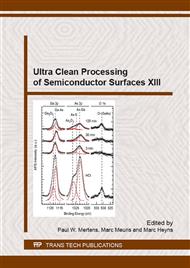p.86
p.91
p.97
p.105
p.111
p.117
p.122
p.129
p.136
Characterization and Development of High Dose Implanted Resist Stripping Processes
Abstract:
With the increase of implantation dose in new technologies, implanted photoresist stripping is even more challenged in terms of efficiency and substrate consumption. In this work, the effect of implantation parameters (energy and implanted specie) on the photoresist modifications are studied and several plasma chemistries are evaluated to remove it. A good removal efficiency with a low substrate consumption has been found with H2-based processes especially N2H2.
Info:
Periodical:
Pages:
111-116
Citation:
Online since:
September 2016
Keywords:
Price:
Сopyright:
© 2016 Trans Tech Publications Ltd. All Rights Reserved
Share:
Citation:


